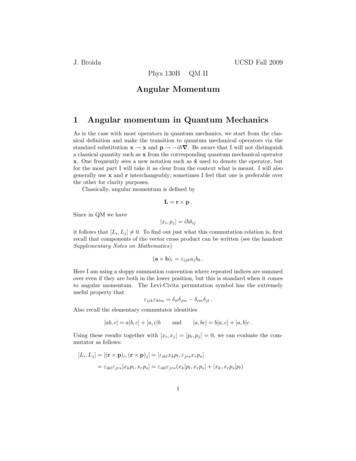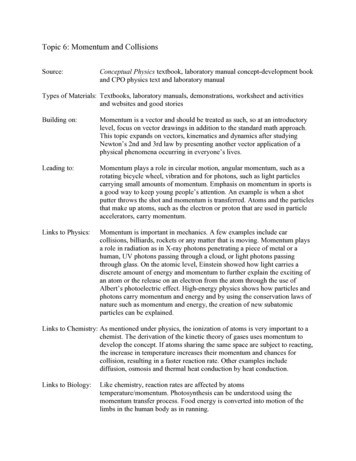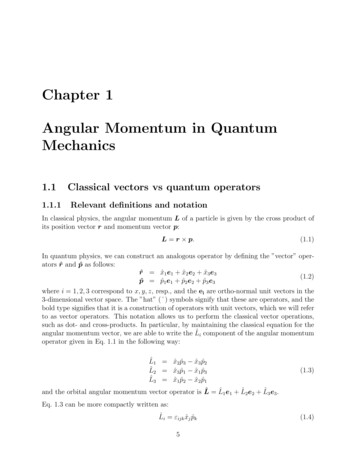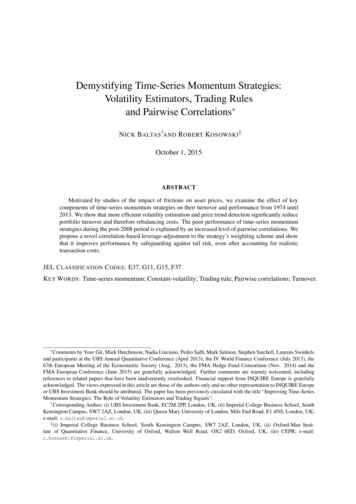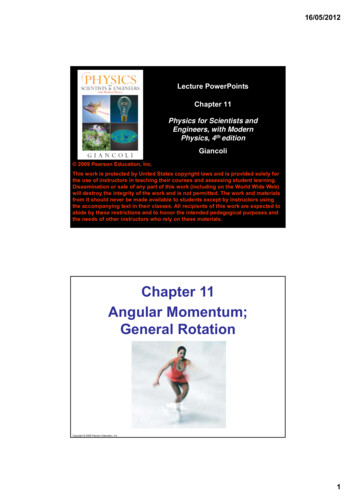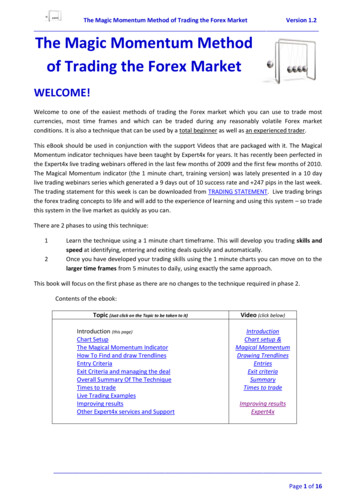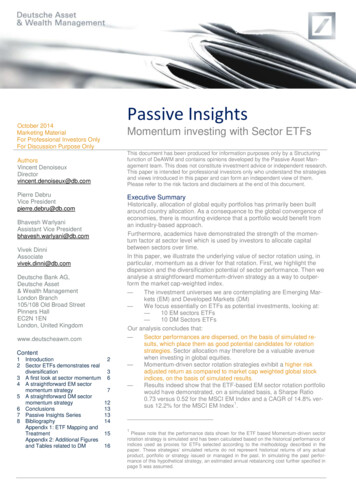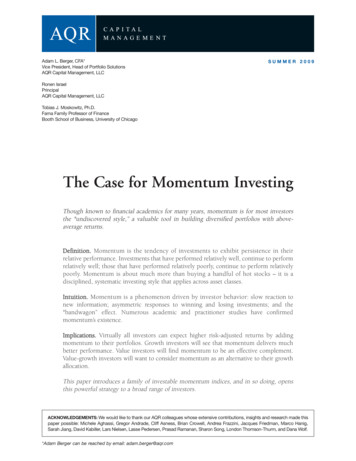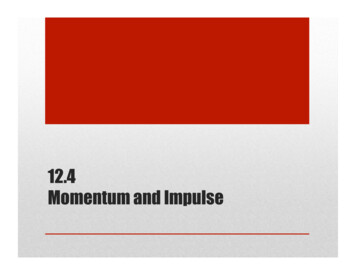
Transcription
12.4Momentum and Impulse
MomentumLet’s assume there’s a car speeding toward you, out ofcontrol without its brakes, at a speed of 27 m/s (60 mph).Can you stop it by standing in front of it and holding outyour hand? Why not?Unless you're Superman, you probably don't want to trystopping a moving car by holding out your hand. It's too big,and it's moving way too fast. Attempting such a feat wouldresult in a number of physics demonstrations upon yourbody, all of which would hurt.
MomentumWe can't stop the car because it has too much momentum.Momentum is a vector quantity, given the symbol “p”,which measures how hard it is to stop a moving object. Ofcourse, larger objects have more momentum than smallerobjects, and faster objects have more momentum thanslower objects.
MomentumMomentum can be defined as "mass in motion." All objectshave mass; so if an object is moving, then it has momentum.Momentum depends upon 2 variables:1. Mass2. Velocity
MomentumFormula:Momentum mass x velocityp m vp momentum (kg m/s)m mass (kg)v velocity (m/s)
Momentum is a vector Momentum is a vector, so the direction of momentum isthe same as the direction of the velocity vector. An object’s momentum will change if its mass and/orvelocity (speed and direction) changes.
Momentum is a vector According to Newton’s laws, a net force causes anobject to accelerate, or change its velocity. A net force, therefore, causes a change in an object’smomentum.
MomentumQuestion:Two trains, Big Red and Little Blue, have the same velocity. BigRed, however, has twice the mass of Little Blue. Comparetheir momentum.Answer:Because Big Red has twice the mass of Little Blue, and BigRed must have twice the momentum of Little Blue.
Momentum Example #1Example #1A supersonic bomber, with a mass of 21,000 kg, departsfrom its home airbase with a velocity of 400 m/s dueeast. What is the jet's momentum?p m vp 21,000 kg 400 m/s eastp 8,400,000 kg m/s east
Momentum Example #2Example #2Now, let's assume the jet drops its payload and hasburned up most of its fuel as it continues its journey toits destination air field.If the jet's new mass is 16,000 kg, and due to its reducedweight the pilot increases the cruising speed to 550 m/s,what is the jet's new momentum?p m·vp 16,000 kg x 550 m/s eastp 8,800,000 kg m/s east
Momentum ExampleExample #3A 588 N halfback is moving eastward at 9 m/s. What is theirmomentum?539.45 kg m/s east
Momentum ExampleExample #4What is the momentum of a 1,000 kg car moving northward at20 m/s.20,000 kg·m/s north
ImpulseIf momentum changes, its because mass or velocity change.Most often mass doesn’t change so velocity changes and thisis acceleration.And then we get:p mass x Δv (Don’t forget Δ is “change in”)p mass x Accelerationp force
ImpulseApplying a force over a time interval to an object changes themomentum. A change in momentum is known as an impulse.The vector quantity for impulse is represented by the letter“J”, and since it's a change in momentum, its units can be onethe same as those for momentum, [kg·m/s], and can also bewritten as a Newton-second [N·s].Note: In sports, impulse is called the “follow through”
ImpulseImpulse Formula:Impulse force x timeImpulse ΔpJ F · t (N·s)J Δp (pf – pi ) (kg·m/s)J Impulsep momentum (kg·m/s)F force (N)t time (s)
Impulse Example #1Let’s assume the bomber from the previous problem, whichhad a momentum of 8,800,000 kg·m/s east, comes to a halt onthe ground. What impulse is applied?J Δp (pf – pi )p 0 - 8,800,000 kg m/s eastp - 8,800,000 kg m/s eastp 8,800,000 kg m/s west
Impulse Example #2If the football halfback experienced a force of 800 N for 0.9seconds to the north, determine the impulse.J F·tJ 800N ( 0.9s )J 720 N·s
Impulse Example #3A 0.10 Kg model rocket’s engine is designed to deliver animpulse of 6.0 N·s. If the rocket engine burns for 0.75 s, what isthe average force does the engine produce?J F· t6.0 N·s F ( 0.75s )6.0 N·s / 0.75 s F8.0 N F
Impulse-Momentum TheoremSince momentum is equal to mass times velocity, we can writethat.We also know that impulse is a change in momentum, soimpulse can be written as J Δp . If we combine theseequations, we find:P mvJ ΔpJ Δp Δ(mv)
Impulse-Momentum TheoremSince the mass of a single object is constant, a change in theproduct of mass and velocity is equivalent to the product ofmass and change in velocity. Specifically:J Δp mΔvSo we're talking about changes in velocity. but what do wecall changes in velocity? Of course, acceleration! And whatcauses acceleration? A force! And does it matter if the force isapplied for a very short time or a very long time? Absolutely itdoes.
Impulse-Momentum TheoremCommon sense tells us the longer the force is applied, thelonger the object will accelerate, the greater the object'schange in momentum!Let’s apply Newton’s Second Law to what we know:F maF m( v/Δt)F (mΔv)/( t)Rearranging:F t m v
Impulse-Momentum TheoremF t m vJ F t P m vTherefore we can say that:J Pm v F t
Impulse-Momentum Theoremm v F tThis equation relates impulse to change in momentum toforce applied over a time interval.To summarize: When an unbalanced force acts on anobject for a period of time, a change in momentum isproduced, known as an impulse.This is the Impulse-Momentum Theorem
Impulse-Momentum Example #1A tow-truck applies a force of 2,000 N on a 2,000 kg car for aperiod of 3 seconds. What is the magnitude of the change inthe car's momentum? p F t p (2,000 N) (3 s) p 6,000 N·s
Impulse-Momentum Example #2A tow-truck applies a force of 2,000 N on a 2,000 kg car for aperiod of 3 seconds. What is the magnitude of the change in thecar's momentum? If the car starts at rest, what will be its speedafter 3s? p 6,000 N·s p (pf – pi ) mvf – mvi6,000 N·s 2,000 · vf – 2,000 · 0Vf 3 m/s
Impulse-Momentum Example #3An impulse of 11 Ns from a rocket engine has 12.5 g offuel. What is the exhaust velocity?m v F t(.0125 kg) (vf – vi) 11 Nsvf 880 m/s
Impulse-Momentum Example #4A Bullet traveling at 500 m/s is brought to rest by animpulse of 50 Ns. What is the mass of the bullet?m v F tm (500 m/s – 0 m/s ) 50 Nsm (50 Ns) / (500 m/s)m .1 kg
Impulse-Momentum Example #5While waiting in a car at a stoplight, an 80 kg man andhis car are suddenly accelerated to a speed of 5 m/s asthe result of a rear end collision. Assuming the timetaken to be 0.3 s, find:a. The momentum of the manb. The force exerted on him by the back of the seat ofthe car.p m·vp 80 kg · 5 m/sp 400 kg·m/sm v F t400 kg*m/s F·0.3 sF 1,333.33 N
result in a number of physics demonstrations upon your body, all of which would hurt. Momentum We can't stop the car because it has too much momentum. Momentum is a vector quantity, given the symbol “p”, which measures how hard it is to stop a moving object. Of course, larger objects have more momentum than smaller objects, and faster objects have more momentum than slower objects .
